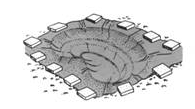Before commencing with the physical planning and building of a garden pond the first step is to take a good look at your garden noting all aspects before deciding where the best place is to build your pond.
Where is the best place to build a garden pond
- Walk around your garden at different times of the day and in different weather conditions – this will help with determining the best location and one that gives the greatest impression of space. Spending time in your garden will also help to determine which location receives the appropriate amount of sunlight. To maintain a healthy garden pond it should receive sunlight for at least 5 hours of the day.
- Sit in the garden and look out at what is already there and how the space is currently used. This will help decide how much of your garden you want taken-up by a pond, how to position a pond in relation to existing trees and plant life, safety features if you have pets and or young children. A pond too near a tree may mean too much shade and high maintenance scooping-up fallen leaves to stop them sinking to the bottom and turning into sludge, which in return will affect water quality.

- Consider the space you have and location to buildings particularly where bedrooms are concerned. Will the sound of running water or the splashes from a fountain pond pump be heard indoors and therefore disturb you or your neighbours particularly at night while sleeping?
- Look at the soil type and water drainage. If your soil is continually damp, you could consider establishing a bog garden instead or as an addition to a pond. Or, perhaps your garden is on a slope and the location of your planned pond is damp and soggy as a result of rainwater run-off. If this is the case, you may want to build a retainer wall as a means of diverting rainwater run-off away from your pond. Run-off risks bringing with it any fertilisers or weedkillers used on surrounding flower beds and lawn which will affect the quality and health of pond water.
- Is your garden sloping and if so how much of a slope is it? This could be an opportunity rather than a hinderance as you could use this type of terrain to build a series of little ponds connected by a fast-flowing stream or series of waterfalls.
When designing a water garden, the rule is to build the biggest one possible. A large, shallow pond is generally healthier, easier to maintain and aesthetically more appealing relative to a small deeper pond.
However, no matter what size garden there will be a pond to suit the space available. Once you have examined the size garden, type of ground and aspect of the land, the next step is to put your thoughts and ideas on paper. Plan, dream and then aim for the design you desire. Decide what obstacles you can turn into opportunities and whether it will be more achievable to divide your water garden creation into more than one project taking each one at a time to complete so that you can have what you desire without it becoming a physical and financial burden.
When you start building your pond and need pond liner, protective underlay and other accessories, then visit Liners Online website where you can use a pond liner size calculator to order exact measurements for your pond build.
Other useful articles >>






Thanks regarding providing these wonderful written content
Roberto Carlos http://socialnetwork.daily-options-picks.info/blogs/viewstory/135811
Terrific webpage you’ve got there
Andrea Pirlo http://blassenweb.net/modules.php?name=Your_Account&op=userinfo&username=KarinMzm42